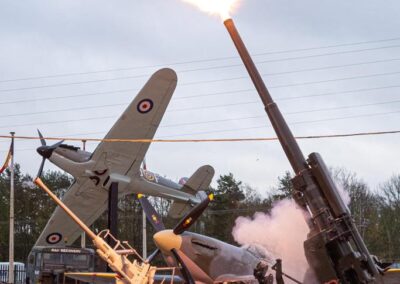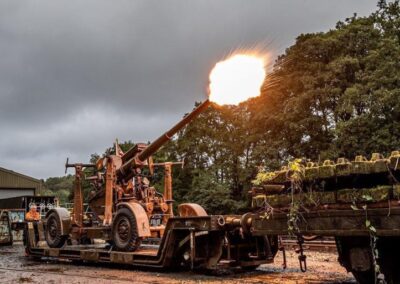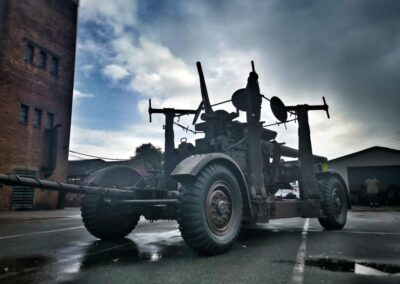3.7 INCH ACK-ACK GUN
It’s History…
After studying a number of gun designs, in 1928 the RA Committee suggested a 3.7 inch Anti-Aircraft Gun, firing a 25 lb shell to a ceiling of 28,000 feet would fill the gap between the existing 3 inch gun and the 4.7 inch then under development. A specification was issued in 1933 for a 3.7 inch gun weighing 8 tons, capable of being towed at 25 mph and brought into action in 15 minutes. Designs were put forward in 1934 and the Vickers design was accepted. Production was authorised in April 1937, and the first guns were delivered in January 1938.
The carriage was complicated and it weighed well over the specified 8 tons so, at first, people preferred the 3 inch for being lighter and handier. Its vastly superior performance soon changed peoples minds and by mid war it was being acclaimed as one of the best guns of its type in existence.
It was continually improved, the most important advance being the Molins Fuze Setter No. 11. This was a combined fuze setter and loading mechanism. The fuse setter descended on the shell, set the fuze and withdrew. The tray swung over to the breech and the round was rammed. The breech closed, tray retracted and the gun fired. The whole operation from putting the shell in the tray and hitting the switch was entirly automatic. This not only took strain off the crew and speeded up the process it also produced a fixed time between fuze setting and firing which aided more accurate prediction of the target.
In January 1941, the War Office demanded a new design with a ceiling of 50,000 feet and a time of flight to that height of 30 seconds. They also required the ability to fire three rounds with a fourth loaded in 20 seconds. The proposals for this new design were based around the Naval 5.25 inch gun and the existing 4.5 inch gun. They were the 5.25 as it stood or lined down to 4.5 or lined down to 3.7 and the 4.5 lined down to 3.7. The 5.25 inch was chosen as the long term solution but the 4.5 lined down to 3.7 inch was adopted as a stop gap until sufficient 5.25 inch guns were available.
To deal with the high velocity required, a new rifling was introduced. Known as RD (Research Department) Rifling, it worked with a specially designed shell. Rifling started at zero with the lands rising to full height just over 4 inches from the start of rifling. At the muzzle end the grooves gradually reduced until at 11 inches from the muzzle the gun had become a smoothbore. The shell had a driving band and twin centring bands at the shoulder. These spread the stress of the shell spinning, evenly along its length. As the depth of rifling decreased, the copper bands were squeezed into canelures in the body. Instead of protruding into the airstream and degrading the flight, these bands were now smooth with the shell body, improving airflow and maintaining velocity.
This gun was introduced in 1943 as the Mark 6. It had a 65 calibre 3.7 inch liner in the jacket of a 4.5 inch Mark 2 gun on a 4.5 inch static mounting. Although only a stop gap, it performed so well it remained in service until 1959.
.





